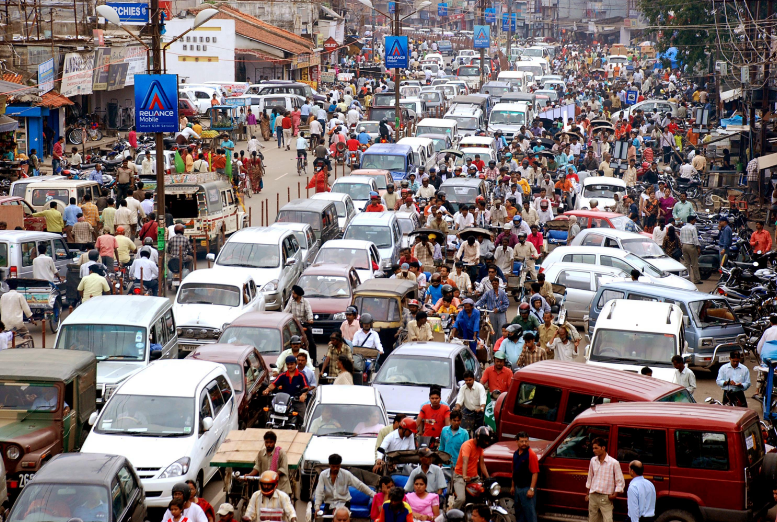By Aniruddha Dasgupta — The Mark News —

India is breaking records, but for all the wrong reasons – its cities are choking on smog.
According to the Health Effects Institute, India has surpassed China in health risks from air pollution. The rush toward personal vehicle ownership and city streets plagued with traffic are at the root of the problem, cutting into the urban quality of life and causing millions of premature deaths every year from pollution and traffic crashes.
This crisis was born on the streets of India’s cities – and that’s the place to start looking for solutions.
________________________________________
A movement in Northern India called Raahgiri Day has become a focal point in a quiet revolution that is seeing pedestrians and cyclists take back their streets from auto traffic. Creating car-free zones in congested downtowns, such as Delhi, not only cuts down on air and noise pollution, people are getting a chance to reinvent their urban spaces.
________________________________________
Indian cities are part of a global movement to help reclaim urban spaces for the people who live in them. From Manhattan, where café chairs sit serenely in the middle of Broadway, to the walkable Historic Peninsula at Istanbul’s ancient center, making space for pedestrians and bicyclists fosters s safer and more accessible cities. These iconic cities, and others, have redesigned some of their streets for people instead of for cars – this one basic change can lead to a better quality of life and a healthier environment.
This shift arrives at a critical time as part of a wider conversation about the importance of safe walking and biking spaces in rapidly growing cities. About 1.25 million people die in traffic accidents each year according to the World Health Organization (WHO), so it’s no longer simply a question of making streets more accessible and enjoyable. It’s also a matter of making cities safer.
New Delhi aims to step up its role as a champion for livable, walkable, less polluted streets. Indian officials are taking advantage of the wild popularity of Raahgiri Day – weekly car-free events that have spread from the pilot city of Gurgaon, just outside Delhi, to 53 cities across India over the course of two years. With impromptu street performances, throngs of yogis practicing in the middle of the road, and groups of children racing on their bicycles, Raahgiri Days are a kind of quiet revolution on urban streets. The value of car-free spaces has become tangible at the local level, and cities are making room for people, rather than the traffic jams that otherwise occupy the road.
Now, all eyes are on Connaught Place, the iconic ring-shaped shopping district at Delhi’s core. A new a three-month pilot project aims to determine whether this perennially vehicle-choked area can operate successfully without cars, making its streets safer and healthier for travel on foot or bike. This would be a major shift for an urban neighborhood that has for decades been largely defined by its traffic. Banning cars would mean a revolutionary change in how people perceive this area and the mega-city around it. But can Connaught Place loosen motorization’s grip?
The benefits of Raahgiri Days extend beyond open spaces and physical activity. Taking a day off from cars has proved to make the city healthier and more walkable, as a whole. Pedestrianized areas in Gurgaon recorded a 21 percent drop in fine particulate air pollution as a result of Raahgiri Day. Many participating areas also saw noise reductions of up to 24 percent. Car-free days help cities re-invent their streets as vibrant human spaces, rather than designated spaces for congestion and noise.
It may not be easy. While the idea of transforming urban high-traffic areas into pedestrian spaces is gaining ground, the Connaught Place initiative has faced opposition, most notably from the New Delhi Traders Association. But fears that pedestrianization will be bad for business are often unfounded. New York City’s influx of pedestrians actually brought a reported boost in retail sales increasing 49 percent in 2012.
The success of Raahgiri Days across India shows that people can take back their streets for shopping, entertainment and cultural events – while still demonstrating long-term value. While removing cars from city streets is not a cure-all, it does start a crucial conversation. Pedestrianizing a central shopping area such as Connaught Place is more than a symbolic victory for urban quality of life. If it succeeds, it could spark a wider discussion in Delhi about what it means to be a more livable city where everyone can live, move and thrive. In dense and thriving cities across the global South, streets represent a lion’s share of open space. These precious spaces cannot be monopolized by car owners; they belong to all citizens.
 Aniruddha (Ani) Dasgupta is the Global Director of the World Resource Institute’s (WRI) Ross Center for Sustainable Cities, WRI’s program that galvanizes action to help cities grow more sustainably and improve quality of life in developing countries around the world. Prior to joining WRI, Ani served as the Director of Knowledge and Learning at the World Bank. Ani has dedicated himself for over 15 years to international development with a focus on the urbanization, urban environment and infrastructure. He was extensively involved in the post-tsunami reconstruction of Aceh, Indonesia as an advisor to the government on housing and infrastructure reconstruction and as the head of the Bank’s housing and infrastructure team.
Aniruddha (Ani) Dasgupta is the Global Director of the World Resource Institute’s (WRI) Ross Center for Sustainable Cities, WRI’s program that galvanizes action to help cities grow more sustainably and improve quality of life in developing countries around the world. Prior to joining WRI, Ani served as the Director of Knowledge and Learning at the World Bank. Ani has dedicated himself for over 15 years to international development with a focus on the urbanization, urban environment and infrastructure. He was extensively involved in the post-tsunami reconstruction of Aceh, Indonesia as an advisor to the government on housing and infrastructure reconstruction and as the head of the Bank’s housing and infrastructure team.





